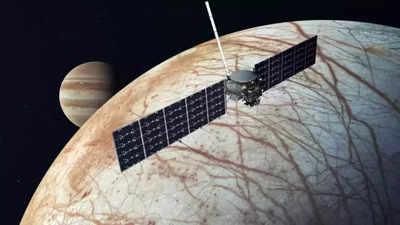- News
- Science News
- Countdown begins: Nasa set to launch Europa Clipper mission to Jupiter today
Countdown begins: Nasa set to launch Europa Clipper mission to Jupiter today
NASA prepares to launch the Europa Clipper mission aimed at exploring Jupiter's moon, Europa, which may host an ocean beneath its icy crust. Scheduled for today on a SpaceX Falcon Heavy rocket, the spacecraft will travel 1.8 billion miles over 5.5 years, performing 49 close flybys and gathering crucial data about Europa's potential to support life.

Image source: NASA
The spacecraft will travel 1.8 billion miles (2.9 billion km) to reach Jupiter in April 2030. It will orbit Jupiter, and conduct 49 close flybys of Europa.
"@EuropaClipper is set to launch on Monday, Oct.
14, on a @SpaceX Falcon Heavy rocket at 12:06pm ET (1606 UTC) from @NASAKennedy. Use #AskNASA to send us your questions," Nasa said in a post on X.
Responding to one of the comments over the time spacecraft will take to reach Jupiter, Nasa said, "The journey will take about 5.5 years, covering a distance of about 1.8 billion miles (2.9 billion kilometers)."
What will Europa Clipper do?
The spacecraft will orbit Jupiter, and conduct 49 close flybys of Europa. On each orbit, the spacecraft will spend less than a day in the dangerous radiation zone near Europa before zipping back out. Two to three weeks later, it will repeat the process. The spacecraft carries nine science instruments, and a gravity experiment that uses the telecommunications system. All science instruments will operate simultaneously on every pass.
The Europa Clipper mission will conduct multiple flybys to collect information about Europa's surface, ice shell, and potential to support life. The European Space Agency's Jupiter Icy Moons Explorer (JUICE), in collaboration with NASA, will also investigate Europa and Ganymede, providing additional insights into these distant moons and their capacity to harbor life.
Europa is a potentially habitable world
Europa, frequently referred to as an "ocean world," has captivated researchers since the 1960s when ground-based telescopes determined that its surface primarily consists of water ice. The moon also possesses essential chemical elements—carbon, hydrogen, nitrogen, oxygen, phosphorus, and sulphur—which are considered the fundamental components necessary for life.
As one of Jupiter's moons, Europa is regarded as one of the most promising locations to search for extraterrestrial life within our solar system. Compelling scientific evidence suggests the presence of a salty ocean beneath its icy surface, indicating that Europa may possess the water, chemistry, and energy sources required to sustain life.
If the Europa Clipper mission confirms the moon's potential habitability, it would significantly expand the possibilities for discovering habitable worlds not only within our solar system but also in the broader universe.
End of Article
FOLLOW US ON SOCIAL MEDIA

